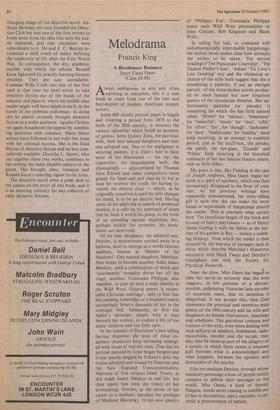Clubbing together
Harriet Waugh
The Scoop and Behind the Screen edited by Dorothy L. Sayers (Gollancz £6.95)
The Scoop and Behind the Screen are two novellas presented (rather in the manner of a parlour game) some 50 years ago on the wireless by a group of prominent detective writers some of whom are still household names. Even those writers who are now less well known are important figures in the history of the development of the detective novel immediately after the First World War. The two novellas, now published for the first time in book form, are amusing if slightly ghostly witnesses to past fun.
Behind the Screen, the shorter of the novellas, was the first of the two scripts to be written in 1930. It was developed at the whim of the writers, as they took over from each other, until quite near the end when some collaboration took place. Hugh Walpole opens the story in elegant, gothic style. Walter, a young, violently insecure young man calls on his fiancee and her family and finds, or imagines, that the evening is being conducted as a charade im- mitating other domestic evenings that he has attended. Perhaps, therefore, he should not have been so particularly startled when, as he listens to his fiancee's mother reading aloud to the family, he becomes aware that 'behind the screen, lying there huddled up almost as though in sleep, his dreadful head turned towards Wilfred, pale ashen, lying upon an arm, his heavy body crumpled up in a kind of strange attitude as though someone had twisted its limbs in different directions, there, dead beyond any ques- tion, lay Dudden. Dudden dead, and Dud- den horribly dead.'
At this point Agatha Christie takes over the story and, rather in the manner of nan- ny, raps the assembled cast over the knuckles. To be busy is to be healthy: so she swiftly moves away from the emotionalism of the previous chapter and puts the characters to work. The hero, Wilfred, regains possession of his faculties 'the numbing feeling of paralysis. passed away. He was himself once more, cool, efficient, able to take command of the situation.' However, he is rather undermined by the end of the chapter when it transpires that one of his surgical instruments (he is a medical student) is missing.
Then Dorothy L. Sayers takes over and broadens the issue by introducing the suspi- cion that the unspeakably caddish Dudden was drugged before he was stabbed. In the next chapter Anthony Berkeley concen- trates on the thinking of the police while E. C. Bentley produces a spatter of confes- sions. The ending is left to Ronald Knox, who makes sense of the impossible concoc- tion.
The Scoop drops Hugh Walpole and Ronald Knox in favour of Freeman Wills Croft and Clemence Dane. Apparently this slightly longer novella was planned by the writers before getting to work under the general editorship of Dorothy L. Sayers. In doing so, it loses some of the high spirits of Behind the Screen without gaining any ex- tra credibility. The story is set in the newspaper offices of The Daily Star as it follows the fortunes of a young hack as he tries to solve the murder of a good-time girl before the police. One junior reporter has already been murdered while covering the story. The murder weapon turns out to be an oriental hair grip. Added complications occur when it transpires that there are two of them. Then after some rather obviously introduced red herrings, and the attempted murder of our hero'S tiresome girl friend, the murderer is laid by the heels. The action moves forward in jerks with Clemence Dane writing his own private love story bet- ween a girl and a puppy in the middle of it. Freeman Wills Croft, very properly, con- centrates on the police at work as he does in his own detective fictions, while Dorothy L. Sayers starts the story off and ties up the end, a little late in the day.
The writers all belonged to the Detection Club and the scripts evolved out of their membership of it. It is easy to see the fun they must have had discussing permutations of frivolous ideas none of them would have dreamed of using in their individual novels. Each of them, with the exception of Hugh Walpole, has contributed uniquely to the changing image of the detective novel. An- thony Berkeley not only founded the Detec- tion Club but was one of the first writers to break away from the idea that only the puz- zle mattered, and that characters were subordinate to it. He and E. C. Bentley in- troduced a mild touch of reality befitting the modernity of life after the First World War. In consequence, the dry, academic puzzles with which the scholar Ronald Knox lightened his priestly learning became - obsolete. They are now unreadable. Freeman Wills Croft was one of the first (and at that time the best) writer to take detective fiction out of the hands of the amateur and place it, where the middle class reader might well have hated to see it, in the hands of the plebeian policeman. In doing this he almost certainly brought detective fiction to a wider audience. Agatha Christie yet again broadened the appeal by combin- ing detection with romance. Many better writers have followed in her wake but none with her colossal success. She is the Enid Blyton of detective fiction and no less com- pulsively readable. Dorothy L. Sayers, who put together these two works, combines in her writing the main likeable aspects of the genre. She brought class, romance and Ronald Knox's exacting rigour to the form.
The detective novel owes a great deal to the names on the cover of this book, and it is an amusing curiosity for any collector of early detective fictions.







































 Previous page
Previous page